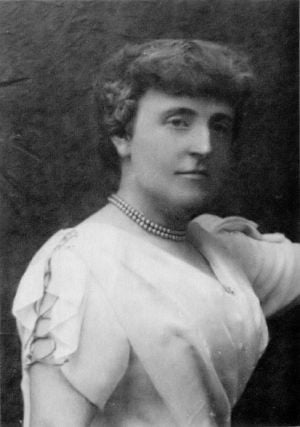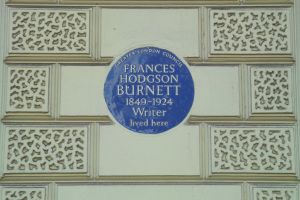Difference between revisions of "Frances Hodgson Burnett" - New World Encyclopedia
David Doose (talk | contribs) m |
|||
| Line 2: | Line 2: | ||
[[Image:Frances Burnett.jpg|thumb|left|Frances Hodgson Burnett]] | [[Image:Frances Burnett.jpg|thumb|left|Frances Hodgson Burnett]] | ||
| − | '''Frances Hodgson | + | ==Childhood and early stories== |
| + | Born '''Frances Eliza Hodgson''' in [[Manchester]], [[England]], she emigrated to [[Knoxville, Tennessee]] in the [[United States]] after the death of her father in [[1864]]. The family lived in bad circumstances, since the promised support from a maternal uncle was nonexistent. Following the death of her mother, 18 year old Frances found herself the head of a family of four younger siblings. She turned to writing to support them all, with a first story published in ''[[Godey's Lady's Book]]'' in 1868. Soon after she was being published regularly in Godey's, ''[[Scribner's Monthly]]'', ''[[Peterson's Ladies' Magazine]]'' and ''[[Harper's Bazaar]]''. Her main writing talent was combining realistic detail of working-class life with a romantic plot. | ||
| − | == | + | ==Marriage and first novels== |
| − | |||
She married Dr. Swan M. Burnett of [[Washington, D.C.]] in [[1873]]. | She married Dr. Swan M. Burnett of [[Washington, D.C.]] in [[1873]]. | ||
| Line 14: | Line 14: | ||
After moving with her husband to Washington, D.C., Burnett wrote the novels ''[[Haworth's]]'' (1879), ''[[Louisiana (book)|Louisiana]]'' (1880), ''[[A Fair Barbarian]]'' (1881), and ''[[Through One Administration]]'' (1883), as well as a play, ''Esmeralda'' (1881), written with [[William Gillette]]. | After moving with her husband to Washington, D.C., Burnett wrote the novels ''[[Haworth's]]'' (1879), ''[[Louisiana (book)|Louisiana]]'' (1880), ''[[A Fair Barbarian]]'' (1881), and ''[[Through One Administration]]'' (1883), as well as a play, ''Esmeralda'' (1881), written with [[William Gillette]]. | ||
| + | |||
| + | [[Image:Frances Burnett blue plaque.jpg|thumb|Frances Burnett's [[blue plaque]] in central London]] | ||
| + | |||
| + | ==Copyright struggles== | ||
In [[1886]] she published ''[[Little Lord Fauntleroy]]''. It was originally intended as a children's book, but had a great appeal to mothers. It created a fashion of long curls (based on her son Vivian's) and velvet suits with lace collars (based on [[Oscar Wilde]]'s attire). The book sold more than half a million copies. In [[1888]] she won a lawsuit in England over the dramatic rights to ''Little Lord Fauntleroy'', establishing a precedent that was incorporated into British [[copyright law]] in [[1911]]. | In [[1886]] she published ''[[Little Lord Fauntleroy]]''. It was originally intended as a children's book, but had a great appeal to mothers. It created a fashion of long curls (based on her son Vivian's) and velvet suits with lace collars (based on [[Oscar Wilde]]'s attire). The book sold more than half a million copies. In [[1888]] she won a lawsuit in England over the dramatic rights to ''Little Lord Fauntleroy'', establishing a precedent that was incorporated into British [[copyright law]] in [[1911]]. | ||
| − | |||
| + | ==Children's Novels== | ||
| + | |||
| + | |||
| + | ==Tragedy and Divorce== | ||
In [[1898]] she divorced Dr. Burnett. She later re-married, this time to Stephen Townsend ([[1900]]), her business manager. Her second marriage would last less than two years, ending in [[1902]]. | In [[1898]] she divorced Dr. Burnett. She later re-married, this time to Stephen Townsend ([[1900]]), her business manager. Her second marriage would last less than two years, ending in [[1902]]. | ||
Her later works include ''[http://www.gutenberg.org/etext/137 Sara Crewe]'' (1888) - later rewritten as ''[[A Little Princess]]'' (1905); ''[[The Lady of Quality]]'' (1896) - considered one of the best of her plays; and ''[[The Secret Garden]]'' (1909), the children's novel for which she is probably best known today. [[The Lost Prince (novel)|The Lost Prince]] was published in 1915. | Her later works include ''[http://www.gutenberg.org/etext/137 Sara Crewe]'' (1888) - later rewritten as ''[[A Little Princess]]'' (1905); ''[[The Lady of Quality]]'' (1896) - considered one of the best of her plays; and ''[[The Secret Garden]]'' (1909), the children's novel for which she is probably best known today. [[The Lost Prince (novel)|The Lost Prince]] was published in 1915. | ||
| − | + | After her first son Lionel's death of [[Tuberculosis|consumption]] in [[1890]], Burnett delved into [[spiritualism]] and apparently found this a great comfort in dealing with her grief (she had previously dabbled in [[Theosophy]], and some of its concepts are worked into ''The Secret Garden'', where a crippled boy thinks he can heal himself through positive thinking and [[affirmations]]). During [[World War I]], Burnett put her beliefs about what happens after death into writing with her novella ''[http://www.gutenberg.org/etext/459 The White People.]'' | |
| + | n [[1893]] she published a memoir of her youth, ''[[The One I Knew Best of All]]''. From the mid-[[1890s]] she lived mainly in England, but in [[1909]] she moved back to the United States, after having become a U.S. citizen in [[1905]]. | ||
| − | + | ||
| + | ==End of Life== | ||
Frances Hodgson Burnett died in [[Plandome, New York]] and is buried in Roslyn Cemetery nearby, next to her son Vivian. A life-size effigy of Lionel stands at their feet. | Frances Hodgson Burnett died in [[Plandome, New York]] and is buried in Roslyn Cemetery nearby, next to her son Vivian. A life-size effigy of Lionel stands at their feet. | ||
Revision as of 01:36, 18 October 2006
Childhood and early stories
Born Frances Eliza Hodgson in Manchester, England, she emigrated to Knoxville, Tennessee in the United States after the death of her father in 1864. The family lived in bad circumstances, since the promised support from a maternal uncle was nonexistent. Following the death of her mother, 18 year old Frances found herself the head of a family of four younger siblings. She turned to writing to support them all, with a first story published in Godey's Lady's Book in 1868. Soon after she was being published regularly in Godey's, Scribner's Monthly, Peterson's Ladies' Magazine and Harper's Bazaar. Her main writing talent was combining realistic detail of working-class life with a romantic plot.
Marriage and first novels
She married Dr. Swan M. Burnett of Washington, D.C. in 1873.
Her first novel was published in 1877; That Lass o' Lowrie's was a story of Lancashire life.
After moving with her husband to Washington, D.C., Burnett wrote the novels Haworth's (1879), Louisiana (1880), A Fair Barbarian (1881), and Through One Administration (1883), as well as a play, Esmeralda (1881), written with William Gillette.
Copyright struggles
In 1886 she published Little Lord Fauntleroy. It was originally intended as a children's book, but had a great appeal to mothers. It created a fashion of long curls (based on her son Vivian's) and velvet suits with lace collars (based on Oscar Wilde's attire). The book sold more than half a million copies. In 1888 she won a lawsuit in England over the dramatic rights to Little Lord Fauntleroy, establishing a precedent that was incorporated into British copyright law in 1911.
Children's Novels
Tragedy and Divorce
In 1898 she divorced Dr. Burnett. She later re-married, this time to Stephen Townsend (1900), her business manager. Her second marriage would last less than two years, ending in 1902.
Her later works include Sara Crewe (1888) - later rewritten as A Little Princess (1905); The Lady of Quality (1896) - considered one of the best of her plays; and The Secret Garden (1909), the children's novel for which she is probably best known today. The Lost Prince was published in 1915.
After her first son Lionel's death of consumption in 1890, Burnett delved into spiritualism and apparently found this a great comfort in dealing with her grief (she had previously dabbled in Theosophy, and some of its concepts are worked into The Secret Garden, where a crippled boy thinks he can heal himself through positive thinking and affirmations). During World War I, Burnett put her beliefs about what happens after death into writing with her novella The White People. n 1893 she published a memoir of her youth, The One I Knew Best of All. From the mid-1890s she lived mainly in England, but in 1909 she moved back to the United States, after having become a U.S. citizen in 1905.
End of Life
Frances Hodgson Burnett died in Plandome, New York and is buried in Roslyn Cemetery nearby, next to her son Vivian. A life-size effigy of Lionel stands at their feet.
External links
- Frances Hodgson Burnett at the Internet Movie Database
- Works by Frances Hodgson Burnett. Project Gutenberg
- Frances Hodgson Burnett Biography, photos, bibliography, e-texts and book covers
- Free audiobook of A Little Princess at Librivox
- Free audiobook of Sara Crewe: or, What Happened at Miss Minchin’s Boarding School at Librivox
- Free audiobook of The Secret Garden at Librivox
Template:EdwardianChildrensLiterature
Credits
New World Encyclopedia writers and editors rewrote and completed the Wikipedia article in accordance with New World Encyclopedia standards. This article abides by terms of the Creative Commons CC-by-sa 3.0 License (CC-by-sa), which may be used and disseminated with proper attribution. Credit is due under the terms of this license that can reference both the New World Encyclopedia contributors and the selfless volunteer contributors of the Wikimedia Foundation. To cite this article click here for a list of acceptable citing formats.The history of earlier contributions by wikipedians is accessible to researchers here:
The history of this article since it was imported to New World Encyclopedia:
Note: Some restrictions may apply to use of individual images which are separately licensed.

